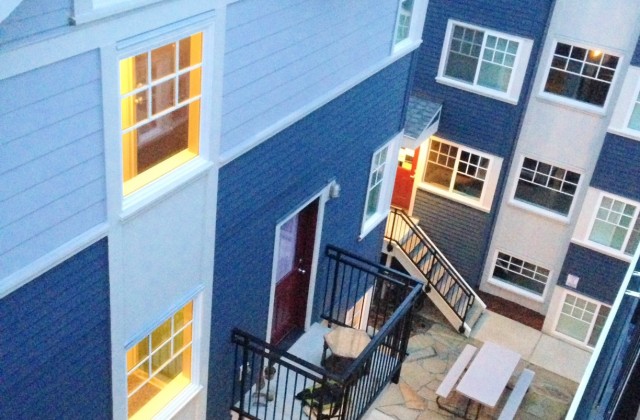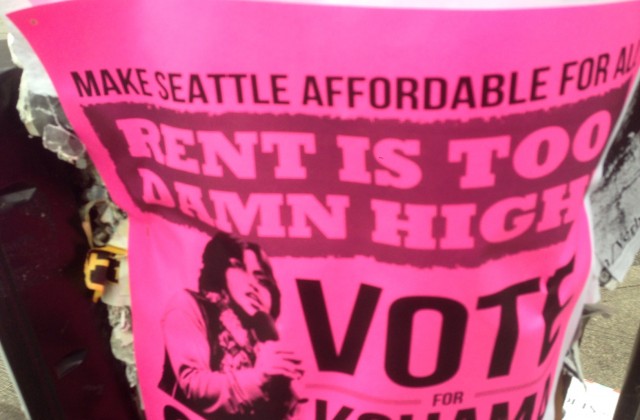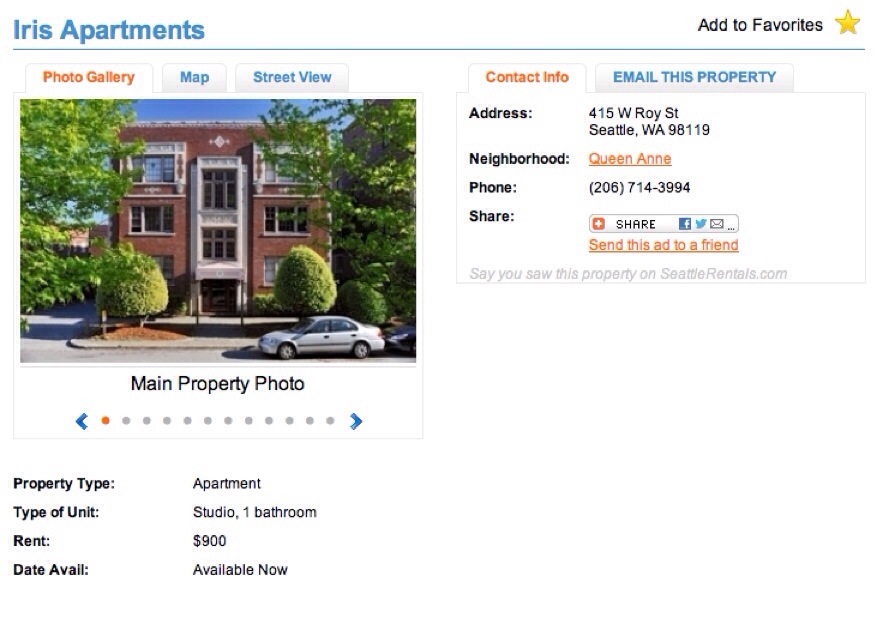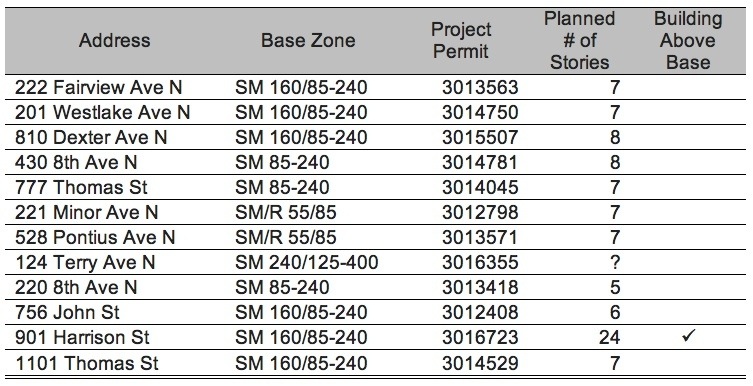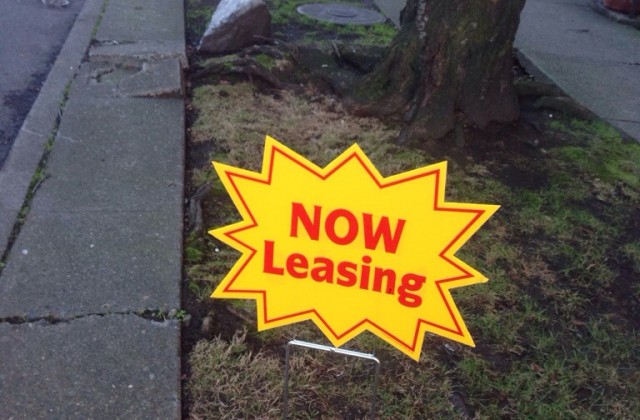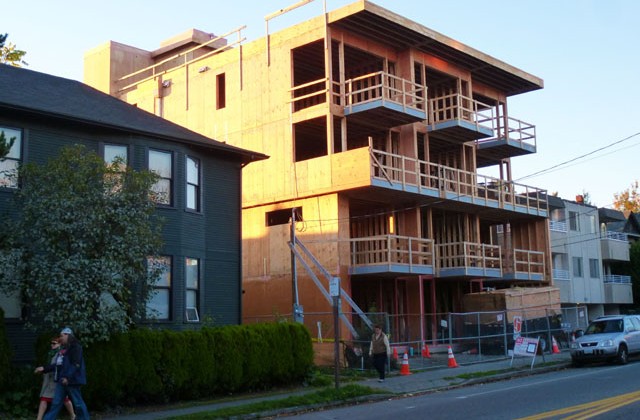Hearing Examiner: Design review “would tend to discourage new development.”
Erica Barnett at Publicola reported today on City action on an appeal to last year’s legislation on microhousing. Smart Growth Seattle weighed in on that proposal pointing out that the design review process would add needless costs, time, and process to microhousing development, costs ultimately born by renters who are currently getting good deal from their rent dollars. We asked then, “why subject a good thing like microhousing to a bad process like the current design review regimen?”
Here’s what the hearing examiner had to say about design review in her rejection of the appeal:
“The evidence fails to show that the proposed legislation would spur new development of micro-housing or congregate residences, compared with what occurs under existing regulation of micro-housing. Clearly, the Appellants fear that this will occur but the record does not demonstrate that this impact would likely occur. If anything, as DPD notes, it would seem more likely that the proposal’s addition of new requirements, such as design review for certain projects which are currently not required to undergo design review, … would tend to discourage new development.”
You might think the we filed the appeal. We didn’t. Ironically it was the opponents of microhousing that filed the appeal which ultimately slowed down the legislation we really didn’t support in the first place. I guess we should be grateful opponents got this decision. The hearing examiner read the legislation and agreed with us: more process and review would keep more projects from moving forward, denying people a great housing option. And the added bonus to this whole thing is the Department of Planning and Development, on the record, admits their own design review process would hinder microhousing!
You can read all the documents here.
Think housing is expensive? Just wait until it’s affordable.
There is a question haunting Seattle—the question of affordability. Throughout the city many people feel like things in Seattle—especially housing—are too expensive. But what is affordable and what isn’t? And if housing prices are too high for people with certain levels of income, what’s the best way to fix that? And what is the City of Seattle considering now and will it help or make things worse? Is there a better solution?
What is affordable?
Affordability is the quantitative or qualitative measure of a relationship to price. According the government, a person shouldn’t spend more than 30 percent of their gross monthly income on housing. A discount for income is applied to this percentage when considering which people to subsidize. Anybody earning 60 percent or less of Area Median Income (AMI) is considered to have a low enough income to need help with rent. By this measure, a couple in Seattle earning $51,150 (80 percent of AMI), for example, can afford housing costs of $1,198 per month.
The biggest driver of housing policy in Seattle these days is not the more than 3,000 people who sleep outside each night or housing for lower income families but something called “workforce housing.” The City defines workforce housing as housing that is priced affordably (according to the measure described above) for people earning 60 to 80 percent of AMI, or $1,075 to $1,198 for a one-bedroom apartment.
Is workforce housing hard to find?
According to the Consolidated Housing and Community Development Plan released by King County the answer is a clear, “No.” Here’s what that plan says about workforce housing in Seattle:
For those moderate income renters, the supply is much more than adequate in all of the sub-regions . . . 38 to 42 percent of all rental units throughout the County are affordable at the moderate income level (75).
And the plan also finds that,
While there appears to be an adequate supply of rental housing for those at 60 percent AMI and above, there is a very inadequate supply of rental housing for households earning 40 percent of median household income or less (69).
There really isn’t lack of supply of housing for people earning 60 to 80 percent of AMI; the real problem is at lower levels of income.
But here’s what the City Council says about workforce housing:
Many retail and service workers that support Seattle’s economic prosperity have difficulty living in the city where they work. Even nurses, teachers, construction workers and many other middle-wage workers face barriers to living in Seattle. For example, a public school teacher’s starting salary of $42,000 suggests that he or she should not pay more than $1,050 per month (30%) for housing. Yet the average rent in Seattle for a 2 bedroom / 1 bath apartment is $1,466.
The logic of the City Council goes like this. Retail workers have a tough time living here. Teachers have are hard time finding a place to live. The teacher who starts out in his first job at $42,000 per year can’t afford a two-bedroom apartment at $1,466.
Wait. Are we talking about retail workers or teachers? And why does this new teacher need a two-bedroom apartment? Is the Council talking about a teacher with a partner who earns no money, since the figure they cite seems based on the City’s normative standard for a couple earning that much? Recent reports peg the average base pay for teachers at about $49,000 per year.
The strained logic of the Council and their example seem to be motivated by the need to create sympathetic case: a poor teacher who would have to spend roughly 42 percent of gross income on housing for a two-bedroom apartment. But their example seems premised on a couple not a single teacher.
What about a one-bedroom unit for our single teacher? A search of Seattlerents.com for apartments between $900 and $1,000 turns up this unit below at the very top of the results.
At $900 per month, our teacher would be paying roughly 26 percent of his income on housing. That’s good isn’t it? And it also is anecdotal validation of the King County Data: there is not a lack of supply of housing choices for people earning 60 to 80 percent of Area Median Income. So there does not appear to be a problem with a lack of supply of workforce housing in Seattle.
Is Incentive Zoning a solution looking for a problem, or is it creating one?
The City is currently charging developers in some areas a fee to build housing over and above existing zoning; instead of a “buy one, get one for half price,” the program is a “buy one get the second one for 11 percent more than what you paid for the first one.” The idea behind the fee—called Incentive Zoning—is that developers will collect more rent from additional units, and therefore more profit if they are allowed to build more density than underlying zoning. Why not capture some of that profit to pay for workforce housing?
Notwithstanding the fact that there does not appear to be a lack of options for people earning 60 to 80 percent of AMI is this fee a good idea? Does this policy of charging developers money to build more housing work? Even though we don’t need more workforce housing but more housing for poorer people, does the fee spur more housing development? Is it really an incentive?
Based on one analysis by the Downtown Seattle Association many new projects simply aren’t taking the “incentive” and choosing not to build additional housing.
Of the 14 projects in this review only two are taking the bonus and the fee that goes with it. Why would developers walk away from all this extra density and extra profits?
In a recent article in the Daily Journal of Commerce Tom Parsons of Holland Development spoke to the issue of why builders don’t see the incentive as, well, an incentive:
Once a structure goes above seven stories, construction materials shift from mostly wood to concrete and other materials that can cost 30 percent more, Parsons said. Developers also must pay for low income housing to reach 125 feet under the South Lake Union rezone, so Parsons said shorter buildings are a better financial choice for these blocks.
“You put all those things together and look at what the market is willing to pay in rent, and the density we can build at base (zoning) is adequate, and it provides the best financial return to our investors,” Parsons said.
The “low income housing” Parsons is referring to is workforce housing, something already being adequately provided by the market. And Parsons doesn’t lay all the blame on the fee, but the fee is part of what tips the scale resulting in less public benefit from more housing and funds for housing.
Based on the numbers it looks like the program which is intended to “incentivize” more building is actually discouraging it. There are risks and costs associated with building more units and the fee simply adds another one. Instead of stoking supply of new market rate housing, and gathering fees from the building of that new housing to help solve housing need, the fee is discouraging market rate supply and not really building very much new subsidized housing either. The fee is making things worse. If we don’t have a problem in workforce housing now we sure will if the City continues to tax new growth and development.
Even if there were a serious lack of housing priced at workforce levels—60 to 80 percent of AMI, the incentive tool probably wouldn’t solve it. Meanwhile lower income people and families struggle to find a place to live and thousands of others sleep outside in the cold every night.
The incentive program part of the housing problem in Seattle reducing housing supply overall by actually discouraging more building. Maybe developers are lying when they say it’s not worth it to take the bonus units they get by paying the fee. But with the risks that are already inherent with building additional height why add more? And whether you believe them or not, evidence shows builders aren’t paying the fee, which means less money to subsidize anything, even the actual problem.
What’s the answer?
The answer is more housing supply. When the market creates a surplus that means lower prices. Add fees, costs and supply will go down and prices will rise. What the fee on new development does is tax a thing we want more of in our city, jobs and people. If we want to encourage more housing we’d reduce the costs and risks associated with building more instead of adding both with fees.
Letting market rate developers build what they can finance will result in more competition between landlords for tenants. More housing means better deals for everyone looking for a place to live. If banks and investors can’t be paid back for lower priced units, housing, or shelter that’s where subsidies or even less regulation are indicated. Making the case for this is going to take more than just one (long) blog post, but we need to challenge the assumptions being issued from City Hall about housing prices and how we can lower them for all levels of income.
Seattle City Council to host housing forum
Next Thursday, February 13th the Seattle City Council will host a forum on “workforce housing.” Workforce housing is typically defined as housing that is “affordable” for people earning between 60 and 80 percent of Area Median Income, about $42,000 to $52,000 in household income for two people. The current normative standard for housing expenses (what you should pay for housing) is 30 percent of gross monthly income.
There is a myriad of problems with the current definition of affordability and how it’s measured.
I’ll be writing more about this topic later this week, but it’s important that supporters of increased housing choices and supply to show up for the evening portion from 6 to 8.
Why Building Housing In Seattle Is Essential For Social Equity
One of the biggest threats to social equity in Seattle is a shortage of housing. Because when demand for housing overwhelms supply and drives up prices, it is the poor who lose. And the essential solution is this: build more housing.
Landlords and developers both do well in a seller’s market for housing. And the affluent are fine too, because they can always outbid those with less financial means for the limited housing that is available.
But the people who do not fare well are those in the lower end of the income spectrum, who are denied access to the all the opportunities and benefits of living in a a prosperous city like Seattle. When demand is not met by supply, inflated prices across the board put housing increasingly out of reach. And those with the lowest incomes are always priced out of the market the soonest and the furthest.
To be clear, government subsidy for housing is also necessary for the deeper levels of affordability. And due to high costs of production, new housing can often be too expensive for a significant portion of lower-income households. Nevertheless, in a high-demand housing market like Seattle’s, increasing the supply of market-rate housing is imperative for equitable access to housing. Here are ten reasons why:
- First of all, increased supply puts downward pressure on prices throughout the housing market, and that preserves affordability for more households.
- Because supply enable more households to find an affordable option, limited funds for housing subsidy can go further to provide more financial help for the lowest income households who need it most.
- More housing means more choices for people to find an affordable housing option that fits their unique needs, such as microhousing.
- Even expensive new housing helps, because every high-end unit that’s produced absorbs demand from a wealthy consumer who otherwise would be outcompeting those with lower incomes for existing housing.
- Likewise, even if new housing units are small they still absorb demand, which reduces competition for existing single family houses, and preserves more options for families with children to live in the city.
- When new housing is provided near good transit, more households have the option to go car free, which significantly reduces household expenses.
- When new housing is not available, demand will induce renovation of older housing, thereby removing it from the affordable stock.
- More housing expands the tax base and increases funds available to subsidize housing for the lowest income households through programs such as Seattle’s Housing Levy.
- The cost and financial risk of building housing falls on private developers and lenders, not on cash-strapped municipalities—social equity is improved with very little public expense.
- Lastly, in the bigger picture, increasing housing supply in Seattle supports widely adopted sustainable development goals to address sprawl, energy, and climate change, all of which disproportionately impact the less fortunate, whether at the local, regional, or global scales.
In comparison to the above list, the purported downsides of housing development are less tenable. One commonly cited concern is displacement of existing affordable housing. But most of the larger multifamily infill projects in Seattle are built on empty lots or spent commercial buildings, and do not cause any such displacement. In cases where new housing would take out existing low-rent units, preventing the development is likely to be a short-lived victory. Because if the location is desirable, the resultant pent up demand will inevitably accelerate rent increases in any housing that was preserved.
In Seattle, most of the negative noise over new housing is about the impact on neighbors–views, shadows, aesthetics, undesirable tenants, parking, traffic. And what it boils down to is a choice between those who were lucky enough to get theirs first in Seattle, and those with limited financial means who want to find a place to live here now. If social equity is truly the goal, then the latter group must be given priority.
These battles over growth have played out countless times in Seattle, the current example being the debate over rolling back recent upzones in low-rise residential areas. If City Council decides in favor of those who wish to restrict housing development, we should all recognize that they will also be deciding against social equity.
The trends that are creating strong demand for housing in Seattle are not going away any time soon. Seattle has a massive, ongoing need for new housing to meet this demand and control prices. If supply continues to fall behind, not only will more lower-income households be priced out, but the subsidy required to make up for the widening affordability gap will increasingly eclipse available City funding resources.
If there was a shortage of shoes that drove prices so high that only the wealthy could afford good shoes and the poor were going barefoot, it would be obvious that increasing shoe production should be a priority to improve social equity. So too, with housing.
>>>
Dan Bertolet is an urban planner at VIA Architecture and blogs at Citytank.
2014: The Year of Housing Supply
As part of announcing our new partnership supporting the work of Smart Growth Seattle, I was asked to speak at the Seattle Metropolitan Chamber of Commerce’s Community Development Round Table (CDRT). I spoke to the CDRT about 15 years ago about neighborhood development and how private development could be leveraged to support implementation of Seattle’s neighborhood plans. These more recent comments were delivered today as part of a presentation given to the CDRT about the future of microhousing by Foot Print Investments.
In Seattle, some people think that if housing prices go up, we ought to control those prices so they stay the same or go lower using land use regulation and rent control. Planners and City staff should decide prices based on a ratio of gross monthly income to housing cost; and the same planners and staff should determine how much return private investors should receive from successful projects.
This view ignores the fact that real people in the housing market don’t buy housing based on a percentage of their gross income, but on the consideration of the utility and disutility one housing choice over another, only one of which is the monthly price. Even for poor people, location, schools, and safety matter when choosing where to live. The dominant view about housing also ignores the truth that profit is the benefit of successfully taking a risk.
There is a different view in Seattle, however: if we want to affect housing price we need to increase supply to keep up with or exceed demand. If we were truly worried about the price of housing getting too high, then we would permit more housing, and many different kinds of housing, in every neighborhood in Seattle.
These two views about price have been around as long as there have been markets. When wages don’t seem to be going up fast enough and prices seem to high, some people are tempted to intervene, to force the issue. “Let’s set wages and prices so they are predictable; let’s make sure there are more winners than losers.”
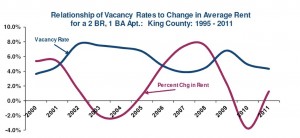
Supply and Demand: Yes, it really works that way!
From King County Consortium Consolidated Housing and Community Development Plan for 2010 – 2014
But we say, “let’s create more jobs and wages will go up; let’s create more housing and prices will go down.” And microhousing is the perfect example of a profitable venture that meets housing need for people who want or need to spend less money on housing.
In today’s housing market producers of housing are vexed by some neighbors who fear change, and some social progressives who want price controls, and a City Council unwilling to loosen their grip on how we use our land. Instead of loosening their grip on how we use land in Seattle, the Council’s tendency, in the face of rising demand, is to clench.
That’s why we created Smart Growth Seattle, to advocate for more innovative housing solutions. We believe that population growth should happen in our city, not in sprawling suburbs. Growth in the city is more sustainable, efficient, and economically beneficial.
- Housing Choice;
- Urban Density;
- Sustainable Development;
- Economic Opportunity; and
- Architectural Diversity
We want more jobs in Seattle and more housing for the workers who are seeking those jobs.
We believe that we should build more single-family homes, a wider variety of multifamily housing, and more workspace for employers all over our city.
Good things happen when we increase housing supply. When there are fewer homes to choose from and demand is high, prices tend to climb and buyers compete with buyers for scarce housing choices. When we allow more building, then there are more homes to choose from, and then landlords and developers have to compete with each other for buyers. More building also means more family wage jobs. We think the second option, building more, makes Seattle a better, more sustainable, and welcoming place to live.
We also believe that the people who build housing and workspace— whether they are use a hammer or an Excel spreadsheet—are building Seattle’s future. We intend to make their case and to argue that people of all incomes, classes, and origins who move to this city to live and work should find a warm embrace, not fear of change and high prices.
Join with me, and the partners of Smart Growth Seattle, in making 2014 the Year of Increased Housing Supply. Invite us back in a year and ask us about the progress we’ve made in shifting our civic discussion away from scarcity to abundance, from fear of change to having open arms for new people, and a local economy that can provide housing and shelter opportunity for everyone in our city.
